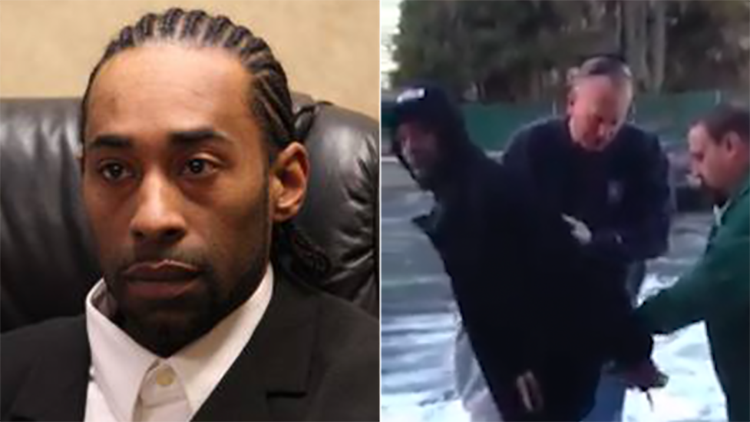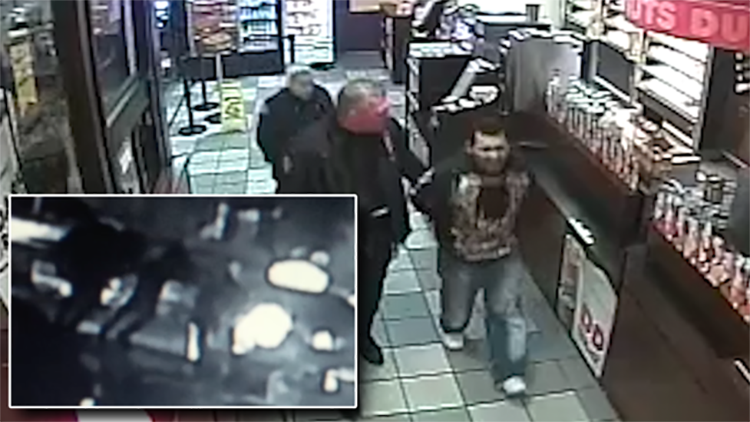Month: March 2021
Job Hunting Tips During a Pandemic
Using LinkedIn to Your Advantage
policing-on-li-relateds
POLICING ON LI: MORE COVERAGE
Policing On LI: Faith Jessie in the studio
POLICING ON LI: MORE COVERAGE
Policing On LI: Video Overview
POLICING ON LI: MORE COVERAGE
Courts: Bystanders have right to record police under the First Amendment
New York last summer cemented into law the public’s right to record police officers as they do their jobs.
After protests against the police killing of George Floyd in Minneapolis, Gov. Andrew M. Cuomo in June signed the “New Yorkers’ Right to Monitor Act.” The law affirms that citizens may video officers in public, as long as they do not hinder the officers’ actions.
Federal courts — though not yet in the circuit covering New York — have also ruled that recording police is covered by the First Amendment prohibition against government abridging freedom of speech or the press.
The Nassau and Suffolk police departments have each paid six-figure settlements within the last seven years to people that alleged their civil rights were violated following arrests while recording officers.
At least one case with similar allegations remains active.
“With the prevalence of cameras both in the public and private sectors, members should assume that their actions are being recorded at all times,” Nassau Police Commissioner Patrick Ryder wrote to officers in a memo last August.
The memo notes that members “shall not interfere with individuals recording a law enforcement activity by intentionally preventing or attempting to prevent that person from recording.”
Suffolk’s policy was updated in 2013, two years after officers arrested a videographer documenting the end of a police pursuit in Bohemia. The county paid the man, Phil Datz, $200,000 to settle a false arrest claim.
“The department recognizes the taking of photographs and/or videos by private citizens and media personnel is permitted within areas open to general public access and occupancy,” Suffolk’s policy reads.
In December 2019, Nassau County paid $175,000 to settle civil rights claims by Kassim Oliver and Joanna Pippins, who alleged that they were tackled and arrested outside their North Bellmore home in 2012 because they were attempting to record officers’ struggle with a family member. The county in 2020 also agreed to pay $30,000 to Adonay Pineda Alcantara, who alleged that officers beat and arrested him after he picked up his cellphone to record a disturbance between police and partygoers outside a New Cassel home in May 2016.
In the active case against Suffolk, Antonio Cruz, then 16, was gathered with friends in the backyard of a St. James home in April 2016 when police arrived and dispersed the crowd. After being directed across the street, Cruz began recording officers and attempted to photograph their badge numbers to document “unprofessional behavior,” according to his civil rights complaint.
In response, the complaint alleged, the officers threw him to the ground and punched, kicked and struck him with a flashlight.
The county has engaged in settlement negotiations under a confidentiality order that bars parties to the lawsuit from disclosing details, according to court records. Cruz’s attorney didn’t respond to requests for comment.
“What’s clear is that police can’t just demand someone stop recording,” said Stephen D. Solomon, a New York University professor of First Amendment law. “There has to be some kind of interference by the person recording.”
Constitutional law experts said that a bystander pointing a cellphone camera can unlawfully obstruct officers by, for example, making physical contact during a disturbance or ignoring an order to back up. On its own, taunting or commenting on an arrest while recording generally does not justify arrest, the experts said.
John Jay College of Criminal Justice Professor Hermann Walz said he believes most officers accept being recorded, even if some react negatively.
“When you watch some of these videos, clearly they don’t want to be taped,” said Walz, a former prosecutor in Brooklyn and Queens. “But I don’t think they care as much anymore, because if they’re realistic, they can’t do anything about it.”
POLICING ON LI: MORE COVERAGE
Your Income Tax Questions Answered
Policing On LI: Case Studies

Cameras and consequences
Four video case histories reveal evidence of unwarranted actions and unjustified force by Long Island police officers, as well as how the public paid millions in compensation for injuries and loss of liberty.
As documented by Newsday, the videos show the role civilian recordings have played in transparency and accountability on police forces that have not been widely equipped with body cameras.
Civilian videos vs. the police accountsFaith Jessie in the studio.
Civilian videos contradicted police accounts
The 34-year-old Black man cursed the cops and violently swung his arms when they tried to handcuff him.
The 71-year-old white Air Force veteran shoved a rookie officer down his porch stairs.
The Latino landscape worker blocked emergency responders from aiding a friend who had suffered a head wound in a bar fight.
The retired Suffolk police lieutenant assaulted a Nassau sergeant with his pickup and fled the scene, prompting a bulletin that branded him wanted, armed and driving a stolen truck.
Police officers in Nassau County filed those four accounts to support making arrests in four different cases over the last seven years. In two of the cases, they swore to descriptions of events that justified using force that caused the men permanent injuries.
But videos recorded by private security cameras and cellphones captured contradicting realities or helped challenge the official accounts. Prosecutors and a judge dismissed the charges against three of the men. A judge convicted the fourth, the retired lieutenant, of reduced counts — after he’d been pulled over at gunpoint on the basis of a falsely issued alarm.
As political and police leaders wrestle with whether to equip Long Island’s major police forces with body cameras, a Newsday investigation of the four cases spotlighted the role civilian videos have played in securing justice absent the sights and sounds of body-worn recorders.
Based on the judgments of independent criminal justice experts, the findings include evidence that officers jailed citizens without cause and used unjustified force while exposing taxpayers to lawsuit liabilities totaling more than $4.6 million so far.
Forty-seven of America’s 50 largest police forces have adopted widespread use of body cameras. The Nassau and Suffolk county police departments are two of the three exceptions, a Newsday survey found — though that may soon change.
Suffolk County Executive Steve Bellone in early March called for equipping large numbers of officers with cameras after one of the few devices worn on the force captured officers kicking a handcuffed alleged car thief. Two officers were suspended; three were placed on modified duty. Bellone has since included body cameras in the county’s police reform plan.
In a police reform plan approved by lawmakers Monday, Nassau County Executive Laura Curran also endorsed widespread body camera use.
Experts’ review
Criminal justice experts, including former top prosecutors, police chiefs and special unit commanders, reviewed the civilian video recordings and the arrest reports in each of the four cases spotlighted by Newsday. They are:

Fred Klein, a former chief prosecutor in the Nassau District Attorney’s Office and currently a Hofstra University Law professor

Brandon del Pozo, a former New York City Police Department deputy inspector and Burlington, Vermont, police chief who has done advanced studies in policing and public policy

Jim Bueermann, a former police chief in Redlands, California, and former president of the National Police Foundation, a Washington, D.C.-based nonprofit aimed at advancing technology in policing

Ayanna Sorett, a fellow at Columbia University’s Center for Justice who served for 15 years as an assistant Manhattan district attorney, including experience prosecuting homicides, gangs and gun trafficking

Joseph Giacalone, a retired NYPD detective sergeant who held posts including leader of homicide and cold case squads and teaches at the John Jay College of Criminal Justice

Joseph Pollini, a John Jay professor of police practice who was a 33-year veteran of the NYPD, commanding a major case squad, robbery squad and a cold case homicide squad.

Bennett Capers, who worked for 10 years in the Manhattan U.S. Attorney’s Office, teaches criminal law at Fordham University Law School and directs Fordham’s Center on Race, Law and Justice. He also served on New York City’s Civilian Complaint Review Board.
Citing differences between the official accounts and the video images, some of the experts questioned why the officers in three cases had not been investigated for, or charged with, criminal conduct.
While declining to discuss specific cases, Nassau district attorney spokesman Brendan Brosh responded in an emailed statement that the office “aggressively prosecutes police officers when charges are supported by the facts.”
It’s almost unjustifiable that there wasn’t probable cause to bring some charges here against the police.
Fred Klein Former chief prosecutor in the Nassau District Attorney’s Office
“It’s almost unjustifiable that there wasn’t probable cause to bring some charges here against the police,” said Klein, referring to the 2014 arrest of Bobby Hayes outside a Uniondale barbershop.
Hayes is the man who was accused of violently swinging his arms to resist arrest. He spent a week in jail, shackled for 23 hours a day, before a cellphone video showed him calmly complying with plainclothes Nassau police Officers Peter Ellison and Carl Arena, who had handcuffed him after he declined to give his name. The recording prompted the Nassau District Attorney’s Office to dismiss Hayes’ case.
A home security camera recording led the district attorney to similarly dismiss resisting arrest and assault charges lodged in 2017 against Robert Besedin, the 71-year-old veteran who had been accused of pushing 24-year-old Nassau police Officer Dominick Mantovani off his porch.
The video showed that Mantovani put his arm around Besedin’s neck and threw him off the porch and onto his head. Besedin’s lawyer, Frederick Brewington, said that the impact caused brain damage and that he pressed prosecutors to charge Mantovani and his partner, Officer Stephen Beckwith, with filing a false felony complaint. Prosecutors declined.
Abel Alvarenga Vasquez is the landscaper whose friend suffered a head gash in a fight at the end of a night of heavy drinking. Hempstead Village police slammed Alvarenga against a parked car after he started recording the scene outside the bar with his cellphone. The blow perforated his small intestine.
After a trial, a judge concluded that videos proved Alvarenga could not have hampered first responders because he was handcuffed in a police car when they arrived outside the bar in an ambulance. The judge found Alvarenga not guilty of disorderly conduct. As compensation, Hempstead Village agreed to a $4.5 million settlement last May.
Discipline unknown
To determine whether any of the officers faced departmental discipline, Newsday sought access to their internal affairs records under the Freedom of Information Law. Despite last year’s repeal of a statute, known as 50-a, that blocked release of almost any law enforcement personnel information, the Nassau Police Department denied Newsday’s requests or provided documents that were almost totally blacked out.
The blacked-out papers revealed nothing about the officers’ histories of civilian complaints or internal affairs investigations. In some instances, the records provided sparse summaries of departmental violations that included no specifics about any incidents and no indications of whether the department had meted out discipline. Newsday last month sued Nassau police over its withholding of the information. County officials have yet to formally respond to the suit.
Officers involved in two of the four cases examined by Newsday have left their forces.
William Falk, who arrested Alvarenga, retired from the Hempstead police force during a period in which he himself was arrested five times in Nassau and Suffolk counties. He was charged with violating an order of protection that his wife had secured during a divorce. He collects an $84,726-a-year pension.
Arena, one of the officers who arrested Hayes, left Nassau police in late 2015, after about 30 years on the job, with a pension of nearly $150,000 a year.
Newsday’s investigation also showed the limitations of surveillance and cellphone videos. Taken from angles and distances that can often be random, they’re not as immediate as body cameras. And unlike the equipment worn by officers, they don’t always capture audio.
In the case of William Hasper, the retired Suffolk police lieutenant, a security camera across a street captured the events in black and white and without sound. Newsday narrowed the camera’s field of view to focus on the two men. The recording shows their movements, but it is not distinct enough to show details.
Nassau police Sgt. William S. Russell reported that Hasper had repeatedly bumped him with Hasper’s pickup during a parking dispute. Russell’s account led police to issue an alarm that named Hasper as wanted for assaulting an officer and described him as potentially armed and dangerous. The bulletin also identified Hasper as driving a stolen truck even though he owned the Sierra.
Hasper and his lawyer each spoke with detectives within hours after the parking lot incident. He appeared for arrest and surrendered his gun. Still, the Nassau PD left the wanted alarm in effect for two months. Cops stopped him twice on the road, once pulling him over with guns drawn.
“My number one fear with this young officer with his gun, with these guns at my head, is that all it would have taken was for him to get nervous, to trip, and I would’ve taken a round or two center mass right in the middle of my cerebellum,” Hasper recalled in an interview.
‘Everybody behaves better’
Body cameras may have more definitively proved or disproved misconduct in any of these cases. In fact, many experts say the devices are more likely, in general, to exonerate officers.
“There’s cameras everywhere else in the world. People have an incentive right now to capture their own footage on their own porch, in their own store, with their own phone on the street,” said del Pozo. “And they will share it … and they will draw their conclusions before the police department ever gets to see that footage.”
Bueermann called the research around body cameras “pretty extensive now.”
We know that the use of body cameras will reduce complaints against officers and assaults on officers and the use of force by police officers.
Jim BueermannFormer police chief in Redlands, Calif.
“We know that the use of body cameras will reduce complaints against officers and assaults on officers and the use of force by police officers,” he said. “We also know that the use of cameras has what’s called a civilizing effect, which simply means that everybody behaves better when they know that they’re on camera and that somebody in a position of authority is going to review that footage.”
The four cases reviewed by Newsday are linked by more than video. In all of them, the officers described their suspects as cursing, waving their arms or “flailing.”
Hayes was accused of disorderly conduct for what police said was a profane tirade and refusing to provide his last name. He was charged with resisting arrest for “swing[ing] his arms and upper body.”
Besedin was said to have slapped at one of the officer’s hands and to have “violently” flailed his arms.
Hasper allegedly screamed and waved his arms at the sergeant during the road rage incident that escalated into the assault charge.
Alvarenga was described as being belligerent and flailing his arms in the moments before an officer slammed him against a parked car with enough force to perforate his small intestine.
Sorett said that overwhelmingly the Manhattan District Attorney’s Office does not prosecute defendants for a single charge of disorderly conduct because, “That’s seen as pretext” for making an arrest when an officer is angry.
She said that police often use a term like “flailing” as “a catchphrase.”
“Like that’s standard police speak and police jargon,” Sorett said. “And if you go and review any criminal complaint that charges disorderly conduct along with resisting arrest, you’ll find that exact term in all of them. It’s sort of, like, standard boilerplate speak for these types of charges.”
Discussing the disorderly conduct charge leveled by police against Alvarenga, Sorett said she saw no evidence that he had broken the law.
“He was simply annoying them,” she said, referring to the police. “There was no reason to issue a summons in the first place. On its face, he didn’t violate the law.”
POLICING ON LI: MORE COVERAGE
Reporters: Paul LaRocco, Sandra Peddie
Editors: Arthur Browne, Keith Herbert
Photography: Chris Ware, Jeffrey Basinger, Paul LaRocco, Howard Schnapp
Video producers: Jeffrey Basinger, Arthur Browne, Keith Herbert
Video editor: Jeffrey Basinger
Studio reporter: Faith Jessie
Studio producers: Robert Cassidy, Arthur Mochi Jr.
Digital design/UX: James Stewart and Matthew Cassella
Project manager: Heather Doyle
Social media editor: Gabriella Vukelić
Print design: Seth Mates
QA: Sumeet Kaur
Robert Besedin: Thrown to the ground, charged with assault
The man tasked with defending Nassau County against police misconduct claims offered no defense.
“It’s a very disturbing video,” deputy county attorney Ralph Reissman told a federal judge in February 2019, describing a home-security recording of Nassau police officers throwing a 71-year-old man off his front porch in Baldwin. “It looks like a physically unprovoked attack.”
Two years earlier, the officers had told a different story — one that jailed homeowner Robert Besedin for about a week on charges of harassment, resisting arrest and felony assault, a count that carried a prison sentence of 2 to 7 years.
If I didn’t have the camera, nobody’d believe me.
Robert Besedin
Photo credit: Chris Ware
In that telling, Besedin had slapped 23-year-old Officer Stephen Beckwith’s hand; flailed and kicked against getting handcuffed; and pushed 24-year-old Officer Dominick Mantovani off the porch, causing Mantovani to suffer wrist and back injuries, as well as a sprained ankle “as a result of stumbling down 4 steps.”
The Nassau District Attorney’s Office dismissed those allegations almost a year after Beckwith filed them in a First District Court felony complaint that included the standard warning that “any false statement” is a misdemeanor. Besedin is convinced he won exoneration only because his home-security recording so strongly contradicted Beckwith’s account.
Newsday examined Besedin’s arrest as one of four case histories documenting how civilian video recordings have come into play in evaluating police actions at a time when Nassau and Suffolk county police departments are among a small minority of large U.S. police forces that do not equip large numbers of officers with body cameras.
In three of Newsday’s case histories, including Besedin’s, security or cellphone video captured evidence that contradicted police accounts, prompted judges and prosecutors to dismiss arrests and supported lawsuits that saddled taxpayers with paying more than $4.6 million in compensation so far.
Criminal justice experts concluded after reviewing recordings in the three cases for Newsday that the presence of body-worn cameras may have prevented officers from lodging charges that proved baseless.
The fourth case history demonstrated the limitations of interpreting police actions based on civilian videos, which can be taken at any distance or angle and generally do not include sound. Still, the recording captured the events that led the Nassau County Police Department to issue a wanted alarm based on false information. The events convinced a retired Suffolk lieutenant at the center of the case to call for body cameras as standard police equipment.
Cameras and consequences
Watch and ReadSuffolk County Executive Steve Bellone in early March called for equipping large numbers of officers with cameras after one of the few devices worn on the force captured officers kicking a handcuffed alleged car thief. Two officers were suspended; three were placed on modified duty. Bellone has since included body cameras in the county’s police reform plan.
In a police reform plan approved by lawmakers Monday, Nassau County Executive Laura Curran endorsed widespread body camera use.
‘A really strong contradiction’
At Newsday’s request, two experts in police procedures matched the events captured by Besedin’s security camera against the charges spelled out in the complaint filed against him. Each expert concluded that the video showed Mantovani throwing Besedin from the porch rather than Besedin pushing Mantovani down the steps, as the cops alleged in charging him with assault.
“It seems like a really strong contradiction between what you see in the video from the porch and what the officers report in their affidavit,” said Brandon del Pozo, a former NYPD deputy inspector and Burlington, Vermont, police chief who has done advanced studies in policing and public policy.
There’s no evidence in that video that the suspect pushed them and, in fact, it seems to be the opposite.
Brandon del PozoFormer NYPD deputy inspector and Burlington, Vt., police chief
Photo credit: Paul LaRocco
Referring to Besedin and the two cops, del Pozo added, “There’s no evidence in that video that the suspect pushed them and, in fact, it seems to be the opposite — that the suspect was taken down those steps forcefully by the two officers.”
Asked if the presence of officer body cameras would have changed what had happened to Besedin — either before or after the encounter — del Pozo replied in general terms:
“Body cameras almost always confirm the police account of what happened and supply evidence that strengthens their case, but at the very least, body cameras make police more careful about how they write up an incident, since they know they’ve been recorded.”
Jim Bueermann, a former police chief in Redlands, California, who served as president of the Washington, D.C., nonprofit National Police Foundation, which advances police innovation through science and technology, said he was surprised that Besedin’s video did not lead to serious repercussions for Beckwith and Mantovani.
“In most places, this would have resulted in their termination and prosecution on a variety of offenses,” Bueermann said, referring to possible charges related to official misconduct and making false statements. “It looks like the officer just attacks this guy and throws him down.”
Bueermann also said of the officers’ actions, “I think had they had body cameras they would have had a different outcome.”
In most places, this would have resulted in their termination and prosecution on a variety of offenses.
Jim BueermannFormer police chief in Redlands, Calif.
Photo credit: Paul LaRocco
He added the caveat that proper protocols for using cameras, such as ensuring they’re appropriately activated and that footage is frequently reviewed, are generally necessary to have an effect on how officers approach their work: “If you don’t do those things the cameras are just a little bundle of electronics sitting on the officer’s chest.”
Representing Besedin, civil rights lawyer Frederick Brewington said that he unsuccessfully pushed Nassau District Attorney Madeline Singas’ office to charge Mantovani and Beckwith with filing a false felony complaint, based on “a clear indication that these officers had lied.” A spokeswoman for Singas declined to comment, citing Besedin’s ongoing federal civil rights lawsuit against Nassau County, the police department and arresting officers.
James McDermott, president of the Nassau Police Benevolent Association, which represents the two officers, did not respond to requests for comment on their behalf. Also citing the ongoing civil case, Det. Lt. Richard LeBrun, a Nassau police spokesman, declined to comment on behalf of the officers or Commissioner Patrick Ryder.
Despite the June 2020 repeal of the state law that had completely shielded police disciplinary records, the department denied Newsday’s Freedom of Information Law requests for the results of an internal investigation into Besedin’s arrest. Asked for a summary of the investigation, the department claimed an exemption to state public records law.
Asked for the final disposition of the case or any recommendation of discipline to be imposed against Beckwith and Mantovani, the department claimed “no record(s).”
The events of that day
An Air Force veteran, Besedin worked in an automobile repair shop that had been in his family for seven decades. His 2018 suit against Nassau County and the two police officers alleges false arrest, excessive force, wrongful imprisonment and false statements. Besedin has rejected settlement offers as high as $500,000, according to statements from the county filed in the lawsuit.
Beckwith and Mantovani each had less than 18 months with Nassau police at the time of the Feb. 7, 2017, incident. They remain on the county’s payroll, earning roughly $85,000 at the end of 2019, public records show.
Brewington said that Besedin called 911 on the day of the incident to complain that a neighbor’s trash was blowing onto his property. In its only official statement on the case, released in June 2017, the police department reported that “Besedin called 911 on eighteen different occasions within a five hour-period on the date of his arrest” and “threatened and used profanities towards the Communication’s Bureau 911 Operators.”
Besedin denies intentionally making the calls. Interviewed by Newsday, he said that he had spent the afternoon on a couch, ill with his phone at his side, and was surprised when “911 calls me up and they say I’ve been dialing.”
Brewington acknowledged that “profanity was used” and that the calls brought Beckwith and Mantovani to Besedin’s home at approximately 7 p.m., after dark in February.
The security camera aimed down from above the door. The lens captured part of the porch and front steps. The camera did not record sound. Portions of the frame were cast in light and portions were in shadow.
Here’s what the video shows:
The two officers climb four steps up to Besedin’s porch. Mantovani talks on a cellphone. Out of the field of view, Besedin meets the officers at his front door. They enter Besedin’s house, again out of the field of view. They emerge after about 12 minutes.
Mantovani steps down off the porch. He claps his hands twice at his waist. The back of Besedin’s head comes into view in the bottom right corner of the frame. He is turned to the side, facing in the direction of Beckwith. At the edge of the frame, he talks with Beckwith. They leave the frame.
Over the next four minutes, Mantovani stands at the bottom of the stoop. He looks toward the ground, taps his knuckles on a railing, speaks intermittently and appears to laugh while placing one foot up on a step. Beckwith comes into view and goes out three times for several seconds.
Then Besedin’s left arm appears to move at the bottom of the frame. Mantovani reacts by walking up the steps and putting his left hand on Besedin’s left shoulder. Mantovani goes out of the frame, reappears with his arm around Besedin’s neck and throws Besedin down the steps. A total of four seconds elapses between the movement of Besedin’s arm and his plummet to the ground, head first.
Beckwith follows his partner down the stairs. Mantovani bends toward the ground. Besedin, Mantovani and Beckwith are obscured by darkness. Seen in flashes, the two officers appear to handcuff Besedin.
‘Did violently flail’
Here’s how Beckwith described the encounter in criminal complaints:
Supporting a second-degree harassment charge, a noncriminal violation, Beckwith stated that Besedin “did, with intent to alarm [Beckwith], slap [Beckwith’s] outstretched hand while [Beckwith] was giving the defendant lawful orders to back away from police officers conducting a police investigation.”
To charge resisting arrest — a misdemeanor punishable by up to a year in jail — Beckwith asserted that Besedin “did intentionally prevent police officers from performing an official function by refusing to comply with a lawful order of the police to place his hands behind his back and submit to an arrest.”
Accusing Besedin of the felony second-degree assault, which carried the potential yearslong prison sentence, Beckwith wrote that “the defendant, after being advised that he was under arrest by Officers Beckwith and Mantovani and to place his hands behind his back, did violently flail his arms, kick and scream and push Officer Mantovani down 4 steps on the exterior of his home.
“As a result of stumbling down 4 steps,” Beckwith continued, “PO Mantovani did suffer pain and swelling to his left wrist and back, small lacerations to his hands, and substantial pain and swelling to his left ankle, which was subsequently diagnosed as sprained after receiving medical treatment at South Nassau Communities Hospital.”
Del Pozo and Bueermann said that the video shows no evidence that Besedin “violently” resisted arrest or assaulted either of the officers.
“There’s nothing about the video that shows that the suspect was even in a position to push them down the stairs,” del Pozo said.
Reissman, the deputy county attorney, expressed a similar conclusion during the 2019 hearing on Besedin’s lawsuit.
“I did not see any physical threat or force from Mr. Besedin,” he told U.S. District Court Judge Gary Brown, according to a transcript. “So, it’s a case that I think should be settled without going into years of discovery.”
Once under arrest, Besedin was taken to Nassau University Medical Center for treatment of injuries, including scrapes, bruises and back pain. Brewington said in an interview that Besedin also suffered “post-concussion syndrome.”
‘Torn us inside out’
Charged with assaulting a police officer, Besedin was jailed until his family posted $10,000 bail.
Although Besedin’s son, Robert Jr., retrieved the video and shared it with the Nassau DA’s office soon after his father’s arrest, more than 11 months passed before prosecutors moved to have the case dismissed.
At the time, a spokeswoman told Newsday that Besedin’s actions “did not rise to the legal standard” necessary to prosecute him even for harassment, the least serious charge he faced.
“They walked up to me and never said a word to me,” Besedin recalled of the officers. “Next thing I know I’m being thrown down the steps and handcuffed and taken away in a squad car.”
His son said the injuries led Besedin to relinquish his auto repair business.
“It’s almost torn us inside out. It’s caused a lot of stress, money problems,” said Besedin Jr. “Everybody’s gotten kind of on edge.”
Brewington’s legal practice has included representing minority clients who have alleged racially motivated civil rights violations by police on Long Island. In this case, Besedin, Mantovani and Beckwith are white.
“What happened to Mr. Besedin is something that we all should take to heart, because if it happens to him — a veteran who served his country … what happens to the little Black boy who doesn’t have somebody to stand next to him, or family who can bail him out?” Brewington said.
Asked to explain a possible motive for the officers to have thrown Besedin down his stairs, the attorney speculated that the young officers viewed him as a nuisance.
“They had the chance to simply turn around and walk off his property,” he said. “Instead, what they decided to do was, ‘Hey, let’s just take this old guy in and give him a taste. Maybe he won’t call us again on 911.’”

 CASE N0.1
CASE N0.1
 CASE N0.2
CASE N0.2
 CASE N0.3
CASE N0.3
 CASE N0.4
CASE N0.4